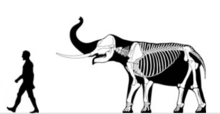Sinomastodon
| Sinomastodon Temporal range:
| |
|---|---|

| |
| Skeletal restoration | |
| Scientific classification | |
| Kingdom: | |
| Phylum: | |
| Class: | |
| Order: | |
| Family: | |
| Genus: | †Sinomastodon Tobien et al., 1986
|
| Species | |
| |
Sinomastodon ("Chinese mastodont") is an extinct gomphothere genus (of order Proboscidea), from the Late Miocene to the Early Pleistocene deposits of south-east Asia (China, Japan, and Indonesia). It is not to be confused with the genus Mammut from a different proboscidean family, whose members are commonly called "mastodons".
The animal was very similar to modern elephants with size ranging from 3.6 to 5.3 m. Several species are known from China, the best known being S. hanjiangensis from the Late Miocene and Early Pliocene of the Shanxi province. It is known from an incomplete skeleton of an adult (measuring 5.3 m) including maxilla, mandibles, teeth, tusks and other materials have been discovered. The Japanese species S. sendaicus described in 1924 from dentary materials from Pliocene deposits has been ascribed to the genus, as well as the species S. bumiajuensis (formerly Tetralophodon) from the late Pliocene of Java. One individual of S. hanjiangensis was a 30-year-old 2.07 metres (6.8 ft) tall and weighed 2.1 tonnes (2.1 long tons; 2.3 short tons).[1]
Taxonomy
According to [2]
†Gomphotheriidae (Gomphotheres)
|
| ||||||||||||||||||||||||||||||
Diet
The diet of Sinomastodon was probably that of a browser, similar to another proboscidean which it shared its environment with, Stegodon.[3]
References
- ^ Larramendi, A. (2016). "Shoulder height, body mass and shape of proboscideans" (PDF). Acta Palaeontologica Polonica. 61. doi:10.4202/app.00136.2014.
- ^ Mothé, Dimila; Ferretti, Marco P.; Avilla, Leonardo S. (12 January 2016). "The Dance of Tusks: Rediscovery of Lower Incisors in the Pan-American Proboscidean Cuvieronius hyodon Revises Incisor Evolution in Elephantimorpha". PLOS ONE. 11: e0147009. doi:10.1371/journal.pone.0147009.
{{cite journal}}: CS1 maint: unflagged free DOI (link) - ^ Zhang, Hanwen; Wang, Yuan; Janis, Christine M.; Goodall, Robert H.; Purnell, Mark A. (26 July 2016). "An examination of feeding ecology in Pleistocene proboscideans from southern China (Sinomastodon, Stegodon, Elephas), by means of dental microwear texture analysis". Quaternary International. doi:10.1016/j.quaint.2016.07.011. Retrieved 4 May 2017.
- Tobien, H., Chen, G.F., and Li, Y.Q., 1986; Mastodons (Proboscidea, Mammalia) from the LateNeogene and Early Pleistocene of the People’s Republic of China. Part I, HistoricalAccount. Mainzer geowiss, mitt., 15, pp. 119–181.



